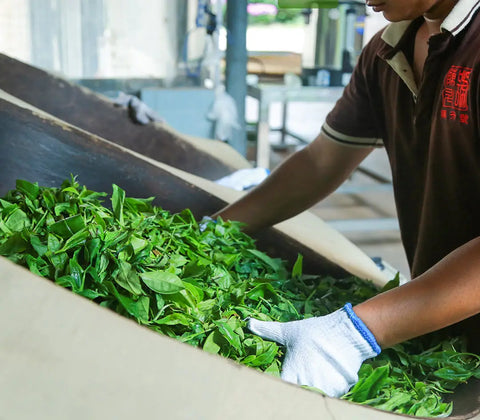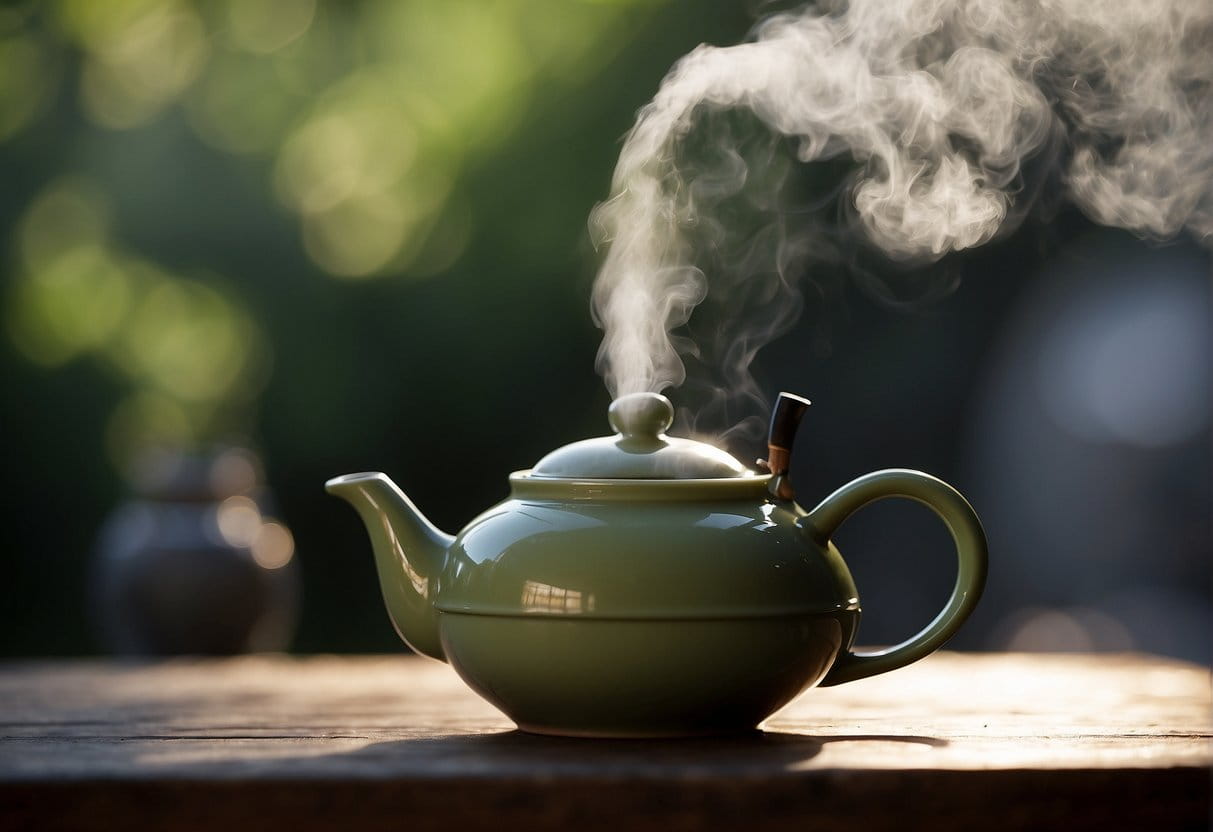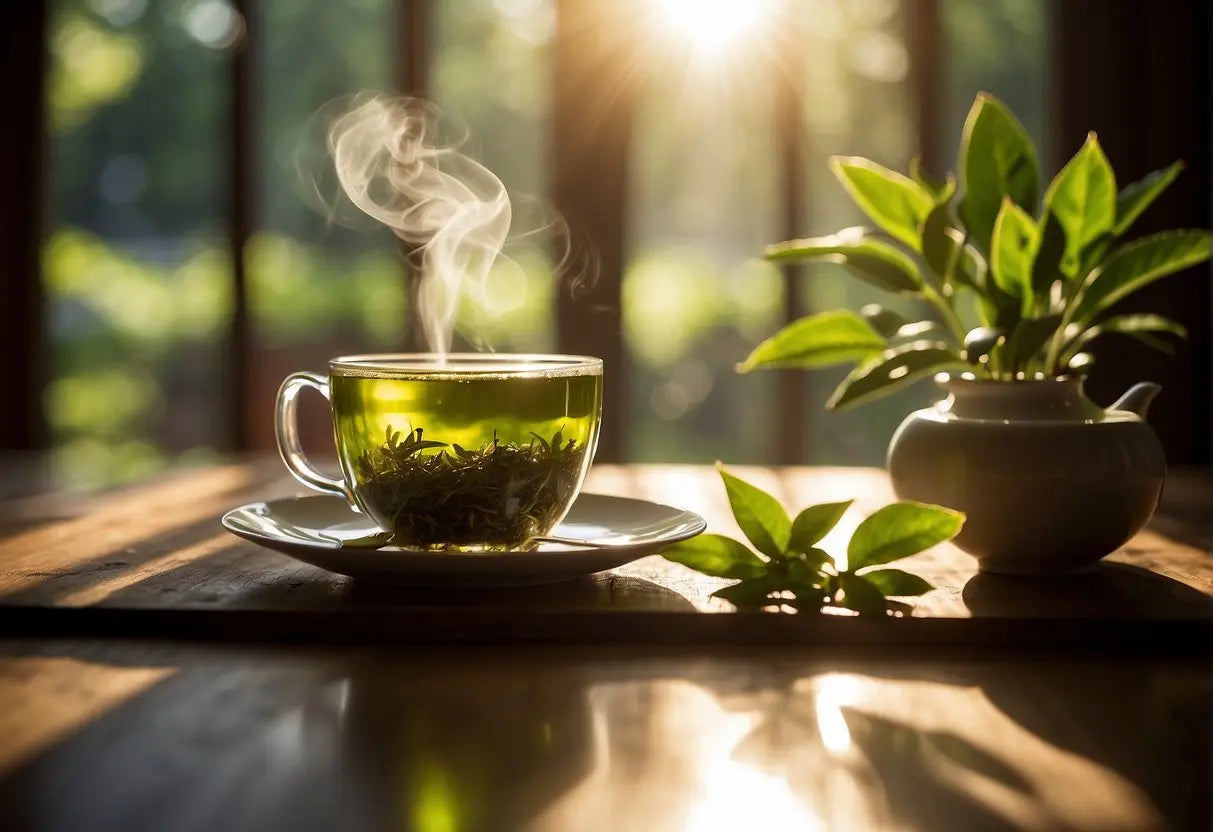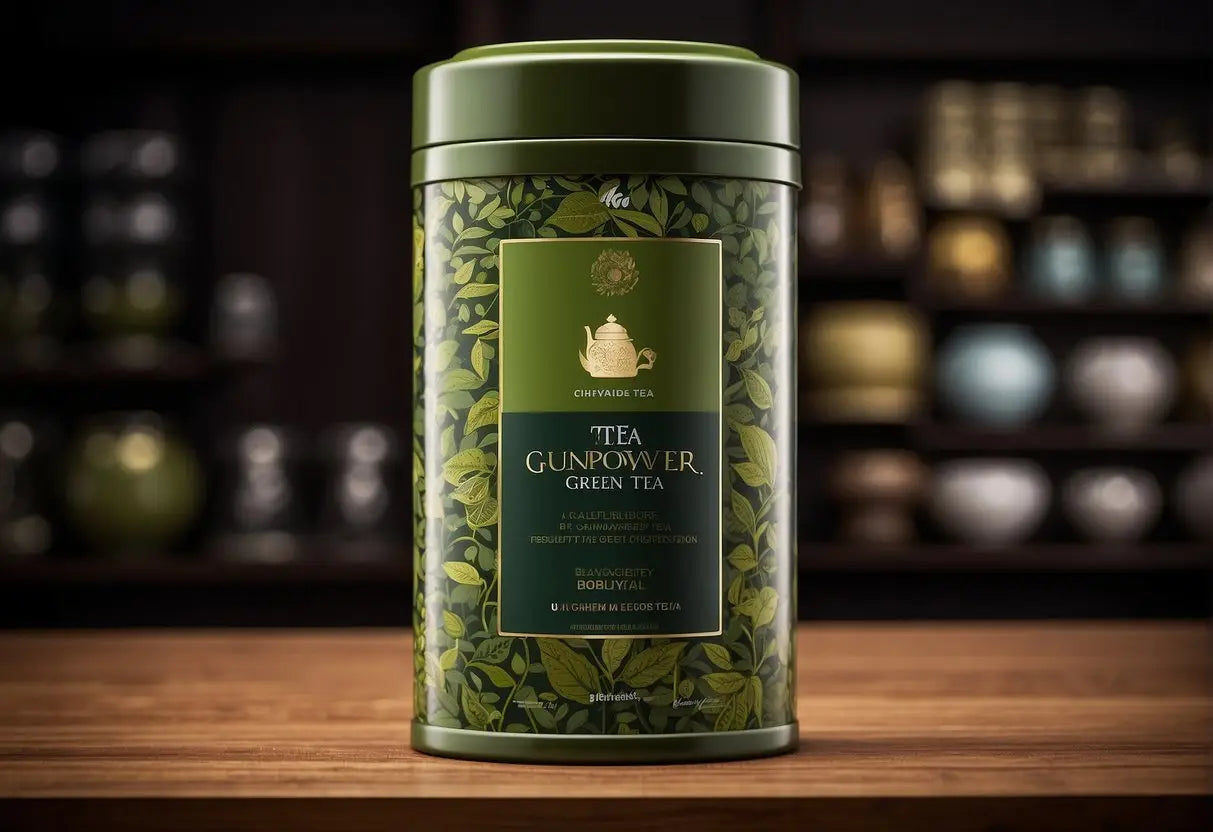What Is Gunpowder Green Tea
Gunpowder green tea, also known as Zhu Cha, is a type of Chinese tea originating from the Zhejiang Province. The tea leaves are withered, steamed, rolled into small round pellets, and then dried. When brewed, these pellets unfurl gracefully, resembling gunpowder exploding, hence the name.
Characteristics:
- Appearance: You'll notice that the pellets are glossy because of the tight rolling, which also helps to retain freshness.
- Flavor: Expect a bold, slightly smoky flavor that is more intense than other green teas.
- Color: The brewed tea has a rich olive green hue.
Benefits:
Bestsellers
Your cup of gunpowder green tea offers several potential health benefits due to its high antioxidant content. These include:
- Enhanced metabolism
- Improved digestion
- Reduced stress
Brewing Tips:
- Water Temperature: To avoid bitterness, use water that is below boiling, around 80-85°C (176-185°F).
- Steeping Time: Steeping for 1 to 3 minutes is ideal; longer steeping yields a stronger taste.
Storage:
For maintaining the quality, store your gunpowder green tea in a cool, dry place away from light, heat, and moisture. Airtight containers are recommended to prevent the absorption of odors.
Remember, the quality of gunpowder green tea can vary significantly, so it's wise to source yours from reputable suppliers to ensure you're experiencing its full potential.
Historical Background

Gunpowder green tea, also referred to as Zhū Chá in Chinese, has a storied past dating to the Tang Dynasty (618–907 AD). Originally crafted in the Zhejiang province of China, the tea's name stems from its distinctive pellet shape, which resembles grains of black powder used in early guns.
- Development: You'll find the tea gained prominence during the Tang and Song dynasties.
- Cultural Significance: Esteemed for its artful presentation and refreshing taste, gunpowder green tea became intertwined with Chinese cultural rituals.
By the time of the Ming Dynasty (1368–1644 AD), gunpowder green tea began to be exported.
- Western Introduction: European traders in the 17th century took a keen interest in the tea and it grew in popularity in the West over subsequent centuries.
You'll discover that the processing method, which involves withering, steaming, rolling, and then drying the tea leaves, has remained relatively unchanged for centuries. This method ensures that the flavor and aroma are effectively preserved, allowing you to experience the tea as drinkers did many generations ago.
- Continued Tradition: Today, gunpowder green tea is still a significant part of traditional Chinese tea culture, celebrated for its bright yellow-green liquor and robust, slightly smoky flavor.
Production Process
Gunpowder green tea, known for its distinctive pellet-like appearance, is produced through a series of meticulous steps:
-
Plucking: You start by hand-picking the young and delicate leaves from the tea plant, typically the top two leaves and a bud for the finest quality.
-
Withering: The plucked leaves are then thinly spread on trays and left to wither, reducing their moisture content and making them more pliable for the next step.
Lao Ban Zhang
-
Steaming or Pan-Firing: To stop the oxidation process, the leaves are either steamed or pan-fired at high temperatures. This process preserves the green color and imparts a unique flavor profile to the tea.
- Steaming gives a grassier taste.
- Pan-firing creates a smokier flavor.
-
Rolling: After the leaves have cooled down, you roll them into tight, small pellets. The rolling process is crucial as it shapes the tea and affects the release of natural oils that define the taste.
-
Drying: The rolled pellets are subjected to another drying phase to further reduce moisture. Careful control of temperature ensures the preservation of flavors and appearance.
-
Sorting: Finally, you sort the tea pellets by size and grade. Only the best pellets are packaged and sold as gunpowder green tea.
Throughout the process, maintaining the quality of the tea is key. Therefore, you perform regular quality checks to ensure the tea's flavor, color, and texture meet the high standards expected of gunpowder green tea.
Appearance and Characteristics

Gunpowder green tea, as you might discern from its name, is unique in texture and form. The leaves are carefully rolled into small, tight pellets resembling grains of gunpowder, hence the moniker. This rolling process is not merely aesthetic; it actually serves to preserve the flavor and aroma of the tea.
When examining gunpowder green tea, you'll notice a dark, glossy hue. The pellets may vary in size but are generally uniform, reflecting quality and care in the processing. Upon brewing, these pellets unfurl gracefully, revealing the full leaf and releasing a robust flavor profile.
Here's what you can expect once you brew gunpowder green tea:
- Color: The liquor color typically ranges from a yellow to a deep golden appearance.
- Aroma: You are greeted with a smoky, slightly grassy scent. The aroma is assertive, hinting at the strength of the flavor it promises.
- Taste: Your palate is met with a bold, slightly astringent but well-rounded taste, often with a hint of smoke that complements its vegetal undertones.
It's recommended to steep the pellets at a temperature below boiling (around 80-85°C or 175-185°F) to ensure you extract the optimal flavor without drawing out excessive bitterness. The ideal brewing time is between 1 to 3 minutes.
Below is a succinct overview of the tea's visual characteristics:
| Aspect | Description |
|---|---|
| Leaf Shape | Small, tightly rolled pellets |
| Leaf Color | Dark green, glossy |
| Liquor Color | Yellow to golden |
Remember, the quality of gunpowder green tea can often be judged by the size and tightness of the pellets: smaller and tighter usually suggests a higher quality.
Taste Profile

Gunpowder green tea has a distinctive taste that you may find both complex and invigorating. Here is a breakdown of what to expect:
-
Flavor: This tea typically possesses a bold, slightly smoky flavor that comes from the unique rolling and drying process. The smokiness is not overwhelming but rather enhances the natural tea flavors.
-
Astringency: You will notice a moderate level of astringency, which provides a pleasant, clean finish. Not too harsh, it can vary depending on the brewing time and temperature.
-
Sweetness: There is an underlying sweetness to gunpowder green tea, often described as a hint of honey or grassy notes that complement the robust profile.
-
Bitterness: If brewed correctly, the bitterness should be minimal. However, if steeped for too long or at too high a temperature, the bitterness can become more pronounced.
Here are some factors affecting the taste:
- Water Temperature: Ideal brewing is at about 175°F (79°C). Too hot, and the tea becomes bitter.
- Steeping Time: Steep for 1 to 3 minutes. Longer steeping might lead to increased bitterness.
- Leaf Quality: Higher quality leaves will result in a more nuanced flavor profile.
- Freshness: Freshness can greatly affect flavor, with fresher leaves yielding a livelier taste.
Make sure to experiment with brewing times and temperatures to find your perfect cup of gunpowder green tea.
Brewing Techniques

When brewing gunpowder green tea, precise techniques can significantly enhance its flavor. Follow these steps carefully:
-
Water Temperature: Heat your water until it is about 170–185°F (76–85°C). Overheating can cause bitterness, as high temperatures will over-extract tannins.
-
Tea Measurement: Use approximately one teaspoon of tea leaves for every 8 ounces of water.
-
Steeping Time: Place the tea leaves in your vessel and pour the heated water over them. Let them steep for 1 to 3 minutes. Longer steeping can increase bitterness.
-
Vessel: A glass teapot or cup is recommended as it allows you to view the unfurling leaves, which is part of the gunpowder green tea experience.
To ensure consistency in flavor, consider the following tips in a tabular format:
| Tip | Description |
|---|---|
| Pre-warm | Pre-warm your vessel with hot water before discarding it and adding the tea leaves. |
| Water Quality | Use filtered or spring water for a cleaner taste, as tap water may introduce unwanted flavors. |
| Leaf-to-Water Ratio | If you prefer a stronger brew, slightly increase the amount of tea rather than extending the steeping time. |
| Second Infusion | Gunpowder green tea leaves are suitable for multiple infusions. Simply add hot water again and steep for an additional minute or so. |
Enjoy your gunpowder green tea with attention to these details for a remarkable taste experience.
Health Benefits

Gunpowder green tea, tightly rolled to resemble gunpowder pellets, preserves its flavors and antioxidants effectively. Consumption can lead to several health benefits.
Rich in Antioxidants: Your tea is loaded with polyphenols such as catechins and flavonoids, which act as powerful antioxidants. These compounds help in neutralizing harmful free radicals, which can prevent cellular damage and reduce inflammation.
-
Weight Management: Regularly sipping gunpowder green tea may aid in weight loss. The tea has been found to slightly boost metabolism and fat burning, assisting in weight management efforts.
-
Heart Health: The antioxidants in your cup of gunpowder green tea may contribute to a healthy heart. Studies indicate that they can lower bad cholesterol and improve good cholesterol levels, potentially reducing the risk of heart diseases.
Enhanced Brain Function: Caffeine, a key active ingredient, can lead to improved brain function. It blocks an inhibitory neurotransmitter called adenosine, which increases the firing of neurons and the concentration of neurotransmitters like dopamine and norepinephrine.
| Oral Health | Stress Relief |
|---|---|
| Antibacterial properties and fluoride in gunpowder green tea can help fight bacteria, improving your oral health and leading to a lower risk of cavities and tooth decay. | The L-theanine in your tea has natural calming properties, which, combined with caffeine, can lead to a state of relaxed alertness and decreased stress levels. |
Remember to consume gunpowder green tea in moderation, as excessive consumption may lead to side effects. Pregnant individuals or those with certain medical conditions should consult with a healthcare professional before adding it to their diet.
Usage and Pairings

Gunpowder green tea, with its robust flavor, is commonly enjoyed on its own, but it can also be paired with a variety of foods. When you drink this tea, its bold taste can enhance and complement certain dishes. Here's how you can use and pair gunpowder green tea:
-
Brewing: To brew gunpowder green tea, steep approximately one teaspoon of tea leaves in hot water (just below boiling point, around 80°C or 175°F) for 1 to 3 minutes, depending on how strong you prefer your tea. This tea can be re-steeped multiple times, with each steeping revealing a different layer of flavor.
-
Pairings:
-
Savory Foods: The smoky and slightly astringent taste of gunpowder green tea pairs well with grilled vegetables, seafood, and lean meats. It can balance the richness of oily or fried foods.
Food Type Example Pairings Grilled Veggies Asparagus, zucchini Seafood Grilled salmon, shrimp Lean Meats Chicken breast, turkey slices -
Sweet Foods: The tea's slight bitterness counteracts the sweetness in pastries and fruits, creating a balanced palate experience.
Food Type Example Pairings Pastries Almond biscotti, plain scones Fruits Pears, apples, peaches
-
-
Daily Enjoyment: You can incorporate gunpowder green tea into your daily routine. It's known to contain antioxidants that offer various health benefits. Drink it in the morning to awaken your senses or in the afternoon to reinvigorate your day.
Remember, always adjust the brewing time and choice of pairings to suit your personal taste preferences.
Global Consumption

Gunpowder green tea, named for its pellet-like appearance, is a type of Chinese tea that has gained popularity worldwide.
China is the largest producer and consumer, but Morocco imports significant quantities for its traditional mint tea. Western Europe and North America have seen a steady increase in consumption due to growing health consciousness.
- China: Dominant consumer, integrates it into daily life.
- Morocco: Highly popular, often brewed with mint.
- Western Europe: Increased interest for health benefits.
- North America: Growing demand in specialty tea shops and online.
Tea shops and online retailers have diversified their offerings, including gunpowder green tea, attracting a broader audience. Your preference for organic products also influences production, with organic gunpowder green tea becoming more available.
The tea’s bold flavor and potential health benefits, such as its antioxidants, contribute to its global appeal.
Note: Your purchase influences market trends, with specialty and health-focused products gaining traction.
Storage Recommendations

When storing gunpowder green tea, maintaining freshness and flavor is paramount. Proper storage extends the tea's shelf life and ensures that its delicate taste remains intact. Here are the key considerations for storing your gunpowder green tea:
-
Temperature: Keep your tea in a cool, dry place. Temperature fluctuations can deteriorate the tea's quality, so avoid storing it near heat sources, such as ovens or stovetops.
-
Light: Protect your tea from light, especially direct sunlight. Light can lead to degradation of the leaves. Store your tea in a cabinet or pantry to minimize exposure.
-
Air: Minimize air exposure by sealing your tea in an airtight container. Oxygen can accelerate the staling process, so removing as much air as possible is essential for preservation.
-
Moisture: Ensure that your container is moisture-free before placing your tea inside. Any moisture can prompt mold to develop.
-
Odors: Store your tea away from any strong-smelling foods or substances, as tea leaves can absorb odors, which can alter the tea's flavor.
Here is a quick reference for your gunpowder green tea storage:
| Factor | Storage Tip |
|---|---|
| Temperature | Cool and stable |
| Light | Avoid direct sunlight and store in darkness |
| Air | Airtight container |
| Moisture | Dry container, avoid humid environments |
| Odors | Separate from strong odors |
By following these guidelines, you'll maintain the quality and extend the lifespan of your gunpowder green tea.
Frequently Asked Questions
Gunpowder green tea, a unique variant of green tea, is known for its distinctive appearance and a rich history that dates back centuries. You may have questions about its health benefits, taste, and proper brewing techniques. This section addresses those queries with clear, concise information.
What are the health benefits associated with drinking gunpowder green tea?
Gunpowder green tea is rich in antioxidants, such as catechins, which can help in reducing inflammation and may lower the risk of certain chronic diseases. Regular consumption can also aid in weight management and may contribute to improved heart health.
How does gunpowder green tea differ in taste and texture from other green teas?
Gunpowder green tea presents a bold flavor that is somewhat smoky and astringent, set apart from milder green teas. Its leaves are rolled into tight pellets, which when brewed, unfurl to release a more concentrated flavor than other loose-leaf green teas.
Why is gunpowder green tea referred to by that name, and what is its history?
The name "gunpowder" arises from the appearance of the tea leaves, which are rolled into small, round pellets resembling gunpowder grains. Originating from China, it is one of the oldest types of green tea, with a history that started in the Tang Dynasty.
How should gunpowder green tea be properly brewed for optimal flavor?
To brew gunpowder green tea, use fresh water heated to about 80-85°C (175-185°F). Steep the tea for 1-3 minutes, depending on how strong you prefer the taste. Avoid overbrewing, as this can result in a bitter flavor.
Can consuming gunpowder green tea lead to any adverse side effects?
While gunpowder green tea is safe for most people, it contains caffeine, which in excessive amounts may lead to nervousness, insomnia, or an upset stomach. Individuals with caffeine sensitivity should consume it cautiously.
In what ways does gunpowder green tea vary from Sencha in terms of processing and flavor profile?
While both are green teas, gunpowder green tea is processed by withering, steaming, rolling, and then drying, forming the characteristic pellets. Its flavor is robust and smoky, contrasting with Sencha's grassy and sweet notes, which result from a different processing technique involving initial steaming to prevent oxidation.
← Older post Newer post →











